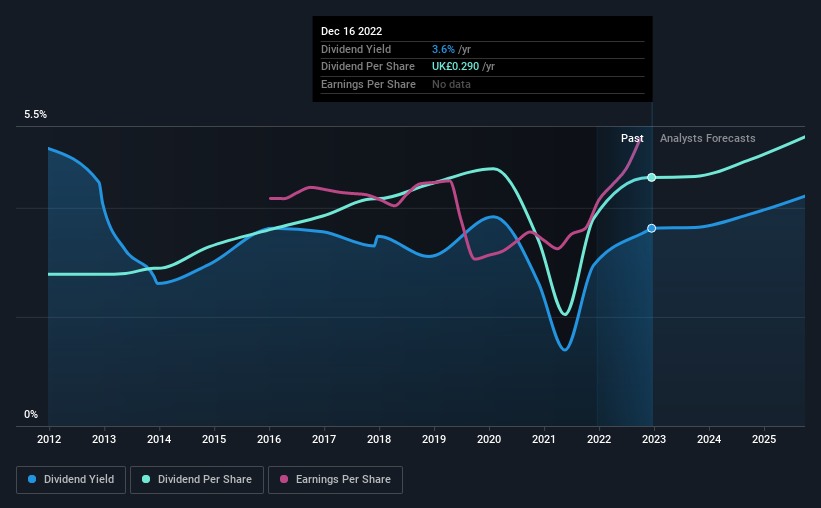Britvic plc (LON:BVIC) Stock Goes Ex-Dividend In Just Four Days
Readers hoping to buy Britvic plc (LON:BVIC) for its dividend will need to make their move shortly, as the stock is about to trade ex-dividend. The ex-dividend date is usually set to be one business day before the record date which is the cut-off date on which you must be present on the company's books as a shareholder in order to receive the dividend. The ex-dividend date is of consequence because whenever a stock is bought or sold, the trade takes at least two business day to settle. In other words, investors can purchase Britvic's shares before the 22nd of December in order to be eligible for the dividend, which will be paid on the 8th of February.
The company's next dividend payment will be UK£0.21 per share. Last year, in total, the company distributed UK£0.29 to shareholders. Last year's total dividend payments show that Britvic has a trailing yield of 3.6% on the current share price of £8. If you buy this business for its dividend, you should have an idea of whether Britvic's dividend is reliable and sustainable. As a result, readers should always check whether Britvic has been able to grow its dividends, or if the dividend might be cut.
See our latest analysis for Britvic
Dividends are usually paid out of company profits, so if a company pays out more than it earned then its dividend is usually at greater risk of being cut. Britvic paid out 55% of its earnings to investors last year, a normal payout level for most businesses. Yet cash flow is typically more important than profit for assessing dividend sustainability, so we should always check if the company generated enough cash to afford its dividend. It distributed 44% of its free cash flow as dividends, a comfortable payout level for most companies.
It's positive to see that Britvic's dividend is covered by both profits and cash flow, since this is generally a sign that the dividend is sustainable, and a lower payout ratio usually suggests a greater margin of safety before the dividend gets cut.
Click here to see the company's payout ratio, plus analyst estimates of its future dividends.
Have Earnings And Dividends Been Growing?
Stocks in companies that generate sustainable earnings growth often make the best dividend prospects, as it is easier to lift the dividend when earnings are rising. If business enters a downturn and the dividend is cut, the company could see its value fall precipitously. With that in mind, we're encouraged by the steady growth at Britvic, with earnings per share up 4.9% on average over the last five years. Earnings growth has been slim and the company is paying out more than half of its earnings. While there is some room to both increase the payout ratio and reinvest in the business, generally the higher a payout ratio goes, the lower a company's prospects for future growth.
Another key way to measure a company's dividend prospects is by measuring its historical rate of dividend growth. Since the start of our data, 10 years ago, Britvic has lifted its dividend by approximately 5.1% a year on average. We're glad to see dividends rising alongside earnings over a number of years, which may be a sign the company intends to share the growth with shareholders.
To Sum It Up
Is Britvic worth buying for its dividend? Earnings per share growth has been modest and Britvic paid out over half of its profits and less than half of its free cash flow, although both payout ratios are within normal limits. To summarise, Britvic looks okay on this analysis, although it doesn't appear a stand-out opportunity.
So while Britvic looks good from a dividend perspective, it's always worthwhile being up to date with the risks involved in this stock. For example - Britvic has 3 warning signs we think you should be aware of.
Generally, we wouldn't recommend just buying the first dividend stock you see. Here's a curated list of interesting stocks that are strong dividend payers.
Have feedback on this article? Concerned about the content? Get in touch with us directly. Alternatively, email editorial-team (at) simplywallst.com.
This article by Simply Wall St is general in nature. We provide commentary based on historical data and analyst forecasts only using an unbiased methodology and our articles are not intended to be financial advice. It does not constitute a recommendation to buy or sell any stock, and does not take account of your objectives, or your financial situation. We aim to bring you long-term focused analysis driven by fundamental data. Note that our analysis may not factor in the latest price-sensitive company announcements or qualitative material. Simply Wall St has no position in any stocks mentioned.
Join A Paid User Research Session
You’ll receive a US$30 Amazon Gift card for 1 hour of your time while helping us build better investing tools for the individual investors like yourself. Sign up here


